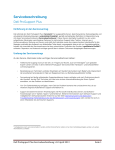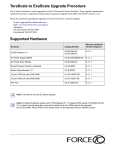Download Dell Force10 S25N-S50N Setup Guide
Transcript
Basic Layer 2 Setup and Buffer Tuning of the S25P for Storage Environments Introduction This document is intended for the users of S-Series S25P switches running FTOS 7.8.1.0 and configured for use in a storage environment. This document describes: • • • • Using the console port to enable all ports on the switch for Layer 2 switching Verifying that the installed FTOS software is FTOS 7.8.1.0 Setting up passwords for managing the switch. For details on management, see the Management chapter in the FTOS Configuration Guide for the S-Series and the Control and Monitoring chapter in the FTOS Command Reference for the S-Series. Optimizing the buffer for use in pure storage environments This document does not cover: • • • Installing optional modules. For installation details, see the document Installing S25P Systems. For a configuration example, see Figure 7 on page 6 here. Adding the switch to an S-Series stack. For stacking configuration details, see the Stacking chapters in the Configuration Guide and the Command Reference listed above. Layer 3 (IP addressing) configuration. For details, see the Interfaces and IP Addressing chapters in the Configuration Guide and Interface Commands chapter in the Command Reference listed above. The full S-Series documentation set is available on the Technical Documentation CD-ROM and from the Documentation tab of iSupport at the Force10 Networks website: https://www.force10networks.com/CSPortal20/KnowledgeBase/Documentation.aspx This document contains the following sections: • • • • Accessing the Console Port on page 2 Setting Up Passwords on page 3 Setting Up Layer 2 Switching on page 4 Managing the Buffer Profile and Setting up Flow Control on page 5 101-00337-00 1 Accessing the Console Port Step Task 1 Install a straight-through RJ-45 copper cable (a standard Ethernet cable) between your system and the console port of the S-Series switch. The console port is at the far left of the faceplate. 2 Turn on the switch by connecting it to power (there is no on/off button). 3 After the switch boots up (the status messages stop), press Enter twice to get the EXEC mode prompt. You should see Force10>, as shown below. Verifying the Software Release and S-Series Model Unless you know that your system has already been installed with FTOS 7.8.1.0 or later, verify that the required version is installed. Task Command Syntax Command Mode Display the installed FTOS version and S-Series model. show inventory EXEC After typing show inventory, press Enter. The system replies with the type of output shown below. In this case, “System Name” (S-Series model type) is “S25P” and “Software version” is “7.8.1.0”. The following screenshot illustrates the expected output of the show inventory command: Force10>show inventory System Name : S25P System Mode : 1.0 Software Version : 7.8.1.0 Unit Type Serial Number Part Number Revision -------------------------------------------------------------* 0 S25-01-GE-24P DL277000000 7590004800 B 0 S50-PWR-AC N/A N/A N/A 0 S50-FAN N/A N/A N/A * - Management Unit Software Protocol Configured -------------------------------------------------------------Force10> If your system does not have the correct software version installed, see the S-Series and FTOS Release Notes, Version 7.8.1.0 for upgrade instructions. A printed copy should be included with your system. Alternatively, see the printed Readme First document that is included with your system. 2 Basic Layer 2 Setup and Buffer Tuning of the S25P for Storage Environments Setting Up Passwords Step Task Command Syntax Command Mode 1 Go from EXEC mode to EXEC privilege mode, commonly called enable mode. After you enter enable and press Enter, the prompt changes to: Force10# enable EXEC 2 Go from EXEC privilege mode to CONFIGURATION mode. The prompt changes to: Force10(conf)# config EXEC privilege 3 Create a password for remote access (through Telnet). For example, for the username “admin” with password “admin”, enter username admin password admin. username name password password CONFIGURATION 4 Create a password for access to Command Line Interface (CLI) modes beyond the EXEC mode. This is typically called the enable password. For example, to create the enable password “admin”, enter enable password admin. enable password password CONFIGURATION The following screenshot illustrates the use of these commands: Force10>enable Force10#config Force10(config)#username admin password admin Force10(config)#enable password admin Force10(config)# You can see the result of setting up a password, or of the other configuration changes that you make by entering, in EXEC privilege mode, show running-config. The following screenshot shows the running configuration from its top up to the part that displays the result of using the commands, above: Force10#show run Current Configuration ... ! Version 7.8.1.0 ! Last configuration change at Wed Oct 27 17:55:30 2008 by default ! redundancy disable-auto-reboot stack-unit ! hardware watchdog ! hostname Force10 ! enable password 7 b125455cf679b208e79b910e85789edf ! username admin password 0 admin In this case, the password was selected to be encrypted, so the result displayed is encrypted. For details on setting passwords, see the Getting Started chapter in the FTOS Configuration Guide for the S-Series and the Security chapter in the FTOS Command Reference for the S-Series. For details on using the show running-config command, see the File Management chapter in the FTOS Command Reference for the S-Series. 101-00337-00 3 Setting Up Layer 2 Switching Step Task Command Syntax Command Mode Select all ports. This example assumes that the stack ID is 0. The prompt changes to: Force10(conf-if-range-gi-0/1-24)# interface range gi 0/1 - 24 CONFIGURATION 2 Enable the selected ports for Layer 2 switching. switchport INTERFACE RANGE 3 Set the maximum Link MTU (frame size) to handle Jumbo frames. mtu 9252 INTERFACE RANGE 4 Administratively enable all ports. no shutdown INTERFACE RANGE 5 Return to CONFIGURATION mode. exit INTERFACE RANGE 6 Repeat the above sequence for the 10GbE ports. interface range te 0/25 - 28 CONFIGURATION 7 After physically connecting the ports, use the show ip interfaces brief command to inspect administrative status (the Status field in the output) and link status (the Protocol field). do show ip interfaces brief INTERFACE RANGE 1 (A space is required before and after the dash in the command.) The following screenshot illustrates the use of these commands (use a space before and after the hyphen): Force10(config)#interface range gigabitethernet 0/1 - 24 Force10(conf-if-range-gi-0/1-48)#switchport Force10(conf-if-range-gi-0/1-48)#mtu 9252 Force10(conf-if-range-gi-0/1-48)#no shutdown 21:22:23: %STKUNIT0-M:CP %IFMGR-5-ASTATE_UP: Changed interface 21:22:23: %STKUNIT0-M:CP %IFMGR-5-ASTATE_UP: Changed interface 21:22:23: %STKUNIT0-M:CP %IFMGR-5-ASTATE_UP: Changed interface 21:22:23: %STKUNIT0-M:CP %IFMGR-5-ASTATE_UP: Changed interface 21:22:23: %STKUNIT0-M:CP %IFMGR-5-ASTATE_UP: Changed interface 21:22:23: %STKUNIT0-M:CP %IFMGR-5-ASTATE_UP: Changed interface 21:22:23: %STKUNIT0-M:CP %IFMGR-5-ASTATE_UP: Changed interface 21:22:23: %STKUNIT0-M:CP %IFMGR-5-ASTATE_UP: Changed interface 21:22:23: %STKUNIT0-M:CP %IFMGR-5-ASTATE_UP: Changed interface ! ----------------------- output truncated ------------- ! Force10#show ip interface brief Interface IP-Address OK Method Status GigabitEthernet 0/0 unassigned NO Manual up GigabitEthernet 0/1 unassigned NO Manual up GigabitEthernet 0/2 unassigned NO Manual up GigabitEthernet 0/3 unassigned NO Manual up GigabitEthernet 0/4 unassigned NO Manual up GigabitEthernet 0/5 unassigned NO Manual up GigabitEthernet 0/6 unassigned NO Manual up GigabitEthernet 0/7 unassigned NO Manual up GigabitEthernet 0/8 unassigned NO Manual up GigabitEthernet 0/9 unassigned NO Manual up ! ----------------------- output truncated ------------- ! 4 Admin Admin Admin Admin Admin Admin Admin Admin Admin state state state state state state state state state to to to to to to to to to up: up: up: up: up: up: up: up: up: Gi Gi Gi Gi Gi Gi Gi Gi Gi 0/1 0/2 0/3 0/4 0/5 0/6 0/7 0/8 0/9 Protocol down down down down down down down down down down Basic Layer 2 Setup and Buffer Tuning of the S25P for Storage Environments Managing the Buffer Profile and Setting up Flow Control Buffer profile management, also called buffer tuning or buffer carving, enables you to modify the way your switch allocates buffers from its available memory, and helps prevent packet drops during a temporary burst of traffic. Force10 recommends the following buffer profile configuration for high-performance storage environments, and is valid for both standalone and stacked units of the S-Series. Buffer Profile Management with FTOS 7.8.1.0 FTOS 7.8.1.0 greatly simplifies buffer tuning for use in dedicated storage environments: Step Task Command Syntax Command Mode 1 Optimize the switch memory buffers for use in dedicated storage environments. buffer-profile global 1Q CONFIGURATION 2 Change from CONFIGURATION mode to EXEC privilege mode. exit CONFIGURATION 3 Save the configuration to non-volatile memory. write memory EXEC privilege 4 Restart the system. reload EXEC privilege For buffer tuning details, see the S-Series Debugging and Diagnostics chapters in the S-Series versions of the FTOS Configuration Guide and the FTOS Command Reference. Buffer Profile Management with FTOS 7.7.2.0a The screenshots, below, are from the S-Series and FTOS Release Notes Version 7.7.2.0. They show examples of buffer configurations excerpted from the running configuration of an S-Series switch running FTOS 7.7.2.0a and optimized for a storage environment. The configuration statements can be copied and pasted into the CLI to accomplish generally the same result as provided in the one command, shown above, in FTOS 7.8.1.0. For more on buffer profile management, flow control, and Ethernet Pause Frames, see that Release Notes document and the FTOS Configuration Guide for the S-Series. Figure 1 Buffer Carving for 1Gig Interfaces in a Standalone Unit ! buffer-profile fp eql-fp buffer dedicated queue0 3 queue1 3 queue2 3 queue3 3 queue4 3 queue5 3 queue6 3 queue7 3 buffer dynamic 1257 Force10# 101-00337-00 5 Figure 2 Defining a Buffer Profile for ASIC Queues [in bytes] ! buffer-profile fp eql-hig buffer dedicated queue0 3 queue1 3 queue2 3 queue3 3 queue4 3 queue5 3 queue6 3 queue7 3 buffer dynamic 1257 Force10# Figure 3 Configuring Internal ASIC Buffers in Stack Unit 0 ! buffer fp-uplink stack-unit 0 port-set 0 buffer-policy eql-hig buffer fp-uplink stack-unit 0 port-set 1 buffer-policy eql-hig Force10# Figure 4 Applying the Buffer Profile to all 1Gig and 10Gig Ports ! interface range gi 0/1 - 24 , te 0/25 - 28 buffer-policy eql-fp Force10# Figure 5 Flow Control for 1Gig Interfaces ! interface range gi 0/1 - 24 flow-control rx on tx on Force10# Figure 6 Refresh Interval for Interface Statistics ! rate-interval 30 Force10# Figure 7 Configuring Ten Gig Ports [assuming all four 10Gig interfaces are available] ! interface range te 0/25 - 28 no ip address mtu 9252 switchport flowcontrol rx on tx on threshold 1024 1024 1054 rate-interval 30 no shutdown Force10# Figure 8 Assigning Ports to a VLAN ! interface vlan 2 untagged gi 0/1 - 24, te 0/25 - 28 Force10# 6 Basic Layer 2 Setup and Buffer Tuning of the S25P for Storage Environments To apply the configuration, above, to other stack members, use the following commands. The interface range used and port-pipes (“port-set 0-1”) designated would depend on the S-Series model. The following sequence presumes that the subject stack member is an S25P model. For an example of configuring an S50N model, see Basic Layer 2 Setup and Buffer Tuning of the S50N for Storage Environments. Step Task Command Syntax Command Mode Apply the “eql-hig” buffer profile to another stack member. buffer fp-uplink stack-unit 0-7 port-set 0 buffer-policy eql-hig For the variable 0-7, enter the stack ID of the stack member CONFIGURATION Select all ports on the switch. interface range gi slot/port - port For the variable slot/port, enter the stack ID of the target 3 Apply the “eql-fp” buffer profile to the ports selected above. buffer-policy eql-fp INTERFACE RANGE 4 Change modes from INTERFACE RANGE to CONFIGURATION. exit INTERFACE RANGE 5 Select all 1GbE ports. interface range gi slot/1 - 24 For slot, enter the stack ID of of the target stack member. CONFIGURATION 1 2 to which to apply the “eql-hig” configuration. For example, for an S25P switch with a stack ID of 1, the command is: buffer fp-uplink stack-unit 1 port-set 0 buffer-policy eql-hig CONFIGURATION stack member, along with 1 for the beginning port number in the range and 24 for the highest-numbered 1GbE port. For example, for an S25P switch with a stack ID of 1, the command is: interface range gi 1/1 - 24 If the switch has 10 GbE modules inserted, include the 10 GbE port range in the command, for example: interface range gi 1/1 - 24, te 1/25 - 28 For example, for a stack ID of 1, enter: interface range gi 1/1 - 24 6 Enable flow control on the 1GbE ports. flow-control rx on tx on INTERFACE RANGE 7 Change modes from INTERFACE RANGE to EXEC privilege. end INTERFACE RANGE 8 Save the configuration to non-volatile memory. write memory EXEC privilege 9 Restart the system. reload EXEC privilege 10 Verify that the buffer profile is applied. show buffer-profile summary fp-uplink EXEC privilege 101-00337-00 7 8 Basic Layer 2 Setup and Buffer Tuning of the S25P for Storage Environments




















